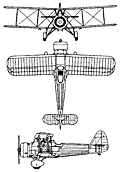 |
Aichi D1A Susie1934 |  |
| DIVE BOMBER | Virtual Aircraft Museum / Japan / Aichi |
 |
Aichi Tokei Denki Kabushiki Kaisha, which was to become a significant aircraft design and construction company during World War II, had been established in Japan during 1899 as a manufacturer of electrical equipment and watches. Like most Japanese companies that sought to expand their capabilities by turning initially to aircraft construction as a stepping stone to experience, that would lead eventually to the creation of indigenous designs, Aichi established a working relationship with Ernst Heinkel Flugzeugwerke in Germany. Wishing to contend in early 1931 for an Imperial Japanese navy requirement for a two-seat carrier-based dive-bomber, Aichi requested Heinkel to design and build an aircraft to meet the navy's specification. Required for operation with float or wheel landing gear, the resulting Heinkel He 50 prototype flew in the summer of 1931 with twin floats. A second version, with wheel landing gear, was duly supplied to Aichi under the export designation He 66. Basically, the He 66 was a two-bay biplane of metal construction with metal and fabric covering. The braced tail unit was conventional, and landing gear of fixed tailskid type. As supplied it was powered by a 365kW Siemens SAM-22B (Jupiter VI) radial engine. Modifications carried out by Aichi included strengthening of the landing gear, and installation of a 418kW Nakajima Kotobuki 2 Kai 1 radial engine. In this form the Aichi Special Bomber was successful in trials against competing prototypes from Nakajima and Yokosuka, and was ordered into production as the Navy Type 94 Carrier Bomber (Aichi D1A1) The 162 production aircraft built, had the radial engine enclosed by a Townend ring, and other modifications included the introduction of slightly swept wings, and replacement of the tailskid by a non-castoring tailwheel. The last 44 had 433kW Kotobuki 3 engines. An improved Aichi D1A2 (Navy Type 96 Carrier Bomber) appeared in 1936-7, powered by a more powerful Nakajima Hikari 1 radial engine, and this model also introduced a NACA engine cowling, wheel spats, and improved windscreens. Production of this version totalled 428. Only a small number of D1A1s remained in use with training units at the time of Japan's attack on Pearl Harbor, on 7 December 1941. About 70 D1A2s were the serving in second-line units, and these were duly allocated the Allied codename 'Susie'.

|  COMPANY PROFILE | |||||||||||||||||||||||||||||||||||||||||||||||||||||||||||||||
 |

|

